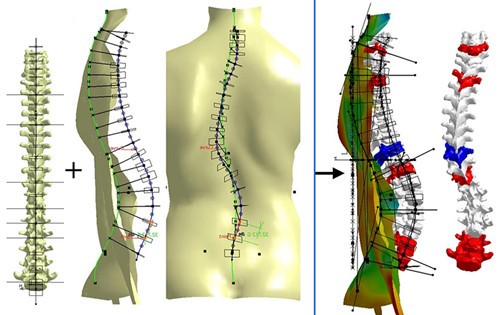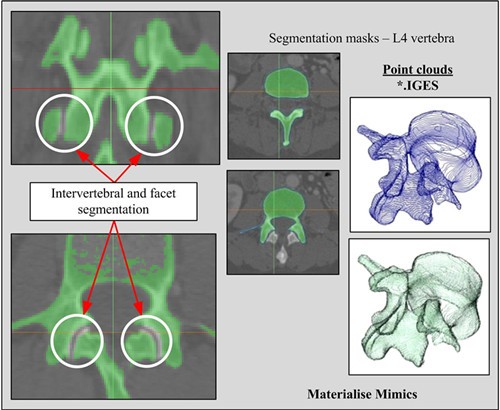Researchers in Serbia have created a diagnostic tool to assess the curvature of the spine in patients with potential scoliosis. The benefit is to reduce repeated radiation exposures to avoid breast cancer in patients. Scoliosis is a condition that affects the curvature of the human spine and usually forms a curvature of the spine on the side of the patient. According to the National Scoliosis Foundation, this affects approximately 2-3% of the population in the United States. Worldwide, up to 28 million people may have the most affected children between the ages of 10 and 16. Diagnostic options are often expensive and involve repeated radiation exposures. On the one hand, doctors can monitor curvature. On the other hand, adolescent scoliosis patients are more likely to develop breast cancer in later life. However, due to a research team in Serbia, this situation is likely to change. Treatment promises multiple benefits for patients with scoliosis Scientists at the University of Kragujevac have proposed a new non-invasive method to diagnose scoliosis using 3D techniques. Traditional scoliosis diagnostic tools include CT or MRI scans that expose a patient to X-rays. Another disadvantage of these patients is that the patient is scanned and lie down without standing up. In addition, it requires an experienced doctor to correctly position the patient for scanning and then to diagnose the image. Kragujevac's team has proposed a new 3D method that can quantify spinal deformities based on the patient's spine model. The researchers used a 3D scan and reconstruction method to create a 3D spine model based on patient data. They used the Materialise Mimics Innovation Suite to reconstruct the spine of the CT scan and generate a model of the patient's spinal deformity. This reduces the need for X-ray based diagnostics while providing 3D measurements. Spinal deformity modeling was originally based on a common 3D model of the spine. Once the patient's CT scan is added to the patient's back surface, a better model can be created. Researchers at Kragujevac University tested the tool on a 372 patient data set. The results show that the system's perfection can eventually replace the radiation diagnosis. In addition, traditional diagnostics typically include subjective judgments of curvature, while 3D models are based on quantitative and objective measurements, resulting in a more standardized test system. By exploiting the three-dimensional nature of scoliosis, researchers have further advanced the diagnosis of the disease. Their system is currently being tested at the Physical Medicine and Rehabilitation Centre of the Orthopaedic and Trauma Clinic in the Kragujevac Clinical Center in Serbia. Ironing Board Cabinets are cabinets for ironing and storing clothes. They are usually made of stainless steel, solid wood (wood fragrant board, solid wood particle board, MDF), tempered glass, and hardware accessories. Generally, cabinets, door panels, silent wheels, and door curtains are used as components. Built-in clothes rails, trouser racks, pull baskets, disinfection lamps and other accessories, using punching, assembly, riveting, welding and other processes, with flame retardant, anti-rodent, seamless anti-cockroach, dust, moth, moisture, clean Beautiful, easy to move and other functions, there are large-capacity intelligent disinfection Ironing Board Cabinet, glass Ironing Board Cabinet without power supply, stainless steel Ironing Board Cabinet, ultraviolet disinfection and cleaning Ironing Board Cabinet, moisture-proof multi-functional Ironing Board Cabinet, men's and women's lockers, dry cockroach-proof Ironing Board Cabinet, folding Ironing Board Cabinet, and simple Ironing Board Cabinet. Commonly divided into flat doors, sliding doors inside and outside the cabinet, etc., the plates used in wardrobes are generally stainless steel, metal, wood, etc., and are one of the commonly used furniture in households. Ironing Cabinet,Folding Ironing Board Cabinet,Ironing Board Storage Cabinet,Freestanding Ironing Board Cabinet Jinan Tri-Tiger Technology Development Co., Ltd , https://www.tigerwoodproduct.com

The general Ironing Board Cabinet is made of 18mm thick materials (particle board, MDF, solid wood board, composite multi-layer board, finger joint board); Plates, louvers, painted panels" or 5mm glass sliding doors; swing doors are generally made of 16mm or 18mm materials); in general, hardware is a matching tool for Ironing Board Cabinet manufacturers, and they do not produce it themselves. There are also a few businesses that produce hardware for Ironing Board Cabinet themselves.
3D modeling of scoliosis provides non-invasive diagnostic options